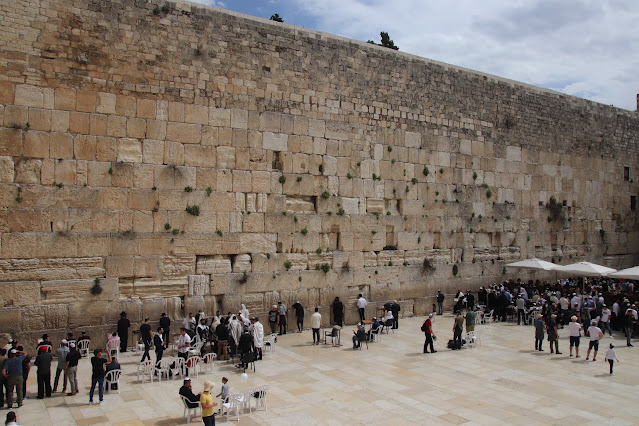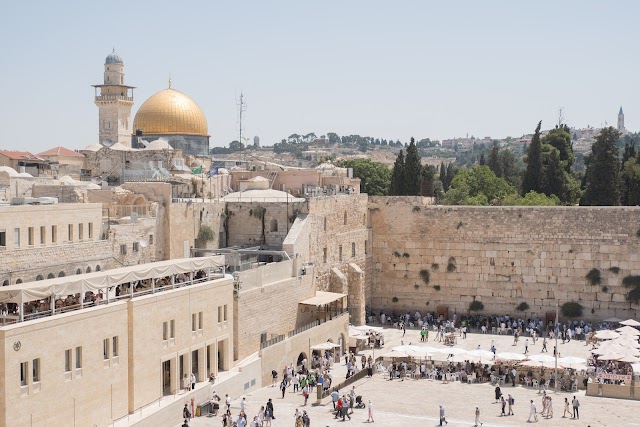Western Wall-Wailing Wall Jerusalem Palestine.
The
Western Wall in the Old City of Jerusalem also called the Kotel and Hebrew has been
a major Jewish sacred site for centuries but what is the Western Wall it's
called the Western Wall because it's a segment of the Western retaining wall of
the rectangular Temple Mount platform this was built under the reign of King
Herod the Great when he launched an ambitious project to renovate the second
Jewish temple in the 1st century BCE and when I say ambitious I mean ambitious
to make the platform he basically flattened Mount Moriah the site according to
Jewish tradition where the creation of the world happened and where Abraham
almost sacrificed Isaac the landscape slopes from north to south down towards
the oldest part of Jerusalem called the City of David so in order to make a
level platform Hera's engineers needed to cut into bedrock on the north side
and build a series of subterranean arches on the southern side to support the
platform the western wall itself is a layer cake of history you can still see
the Herodian era blocks here they are the biggest ones on the bottom then there
are a few layers of Umayyad period blocks from the 7th and 8th centuries.
When the
Islamic Ummah dynasty ruled Jerusalem and then you have a few layers of smaller
stones up top which are from later Islamic periods what you see in all the
pictures though is only a very small segment of the Western retaining wall the
entire length of the western wall extends for almost 500 metres total and a
bunch of it is actually underground because the current street level of the old
city is a few meters higher than the ancient street level you can still see
these levels today if you tour the western wall tunnels where you can find some
of the largest stones in the wall some weighing hundreds of tons Israeli
archaeologists are conducting ongoing excavations down here to which I had the
opportunity to visit in 2018 Jews congregate here because of its proximity to
the Holy of Holies the holiest site for Jews where God's presence is said to dwell
it was located within the former.
Temple of
Jerusalem before the Romans destroyed it in 70 CE II a few hundred years later the
Muslim of Maya dynasty built the Dome of the rock over what most archaeologists
agree was roughly the same spot of the Jewish temple so for centuries the Western
Wall has been the closest you can get to the Holy of Holies without actually entering
the sanctuary itself though technically you can get a little bit closer at a segment
within the western wall tunnels which in and of itself has become a popular place
to pray to we don't exactly know when Jews started to pray at the western wall
in the 16th century the ottoman sultan Suleiman issued an edict permitting Jews
to pray there but the tradition probably stretches back hundreds of years
before that early Christian sources from Lane antiquity described Jews praying
around the ruins of the temple though we're not exactly sure if these texts are
specifically talking about the western wall itself but today when we say the western
wall we generally mean this specific segment which is now an open-air plaza
that can hold about 60,000 people though a lot has changed in just a century
since the founding of the State of Israel if you look at photographs from the
early 20th century you can see that access to the western wall was possible
only through a narrow alley this was because the buildings comprising.
The
Moroccan Quarter and Arab neighborhood founded in the 12th century were built basically
up to the wall itself as you can see from this old photograph following the
arab Israeli war of 1948 Jordan had control of the eastern part of Jerusalem
and restricted Jews from accessing the western wall but during the six-day war
in 1967 the Israeli army defeated the Jordanians and then in a controversial
move levelled the Moroccan quarter and displaced its residents within a few
days this created the open layout of the plaza that we see today but it remains
a sore spot in the history of the israeli-palestinian conflict today millions
of people visit the western wall each year and during pilgrimage holidays like
Passover Sukkot & Shavuot upwards to a hundred thousand Jews visited each
day historically these were holidays when Jews would travel to the temple to
make sacrifices and although animal sacrifice is no longer practiced many Jews
still travel to the western wall to pray during these holidays to give you a
sense of the sheer size of the crowds I took this footage during Passover in
2018 on the pedestrian bridge overlooking the plaza if you visit today you'll
see a lot of people praying reading the Torah or even celebrating Bar Mitzvahs
but another popular devotional practice involves stuffing prayer notes between
the cracks of the stone you can see thousands of them I you visit the wall the Kotel Heritage
Foundation's website even lets you this remotely writing your prayer online and
letting someone else place it for you as a paper note two times a year workers
will remove the prayer notes from the wall but since it's forbidden to destroy
them they are buried on.
The Mount
of Olives treated in a similar manner to a damaged Torah scroll or prayer book
as with many religious sites there's some controversy that's worth mentioning
to the area around the western wall is officially designated by Orthodox
religious authorities as an open-air Orthodox synagogue and thus they enforce
separate men and women sections here and here women's advocacy groups such as
women of the wall have pushed for more a gala terian prayer at the western wall
that would allow women to pray in the women's section reading from Torah scrolls
and wearing Jewish ritual objects such as tefillin and prayer shawls which are generally
reserved only for men this has periodically sparked conflict from
ultra-orthodox Jews who have tried to disrupt these women by shouting over them
or even going so far as to throw rocks and eggs at them in October 2019.
The
Jerusalem Chief Rabbi denounced women of the wall calling on Orthodox women to
protest their prayers a journalist on the ground reported that dozens of boys
and men shouted at the worshippers and a loudspeaker from the men's section
tried to drown out the group's prayer the western wall is thus a glimpse into
the diversity of Jewish practice around the world on this issue while some
denominations will allow women to read the Torah during synagogue services or
even ordained female rabbis other synagogues prohibit these practices I've been
to a lot of famous religious sites but this one really stands out in my mind
just looking at the wall you'll see major eras of history staring you at the
face Herodian Umayyad ottoman but you also see the durability of religious
practice how millions of Jews have held this site sacred for centuries even as
those different dynasties rose and fell if you'd like to learn more about this
area check out my video on the Dome of the rock and as always.







0 Comments
if you have any doubts, please let me know.